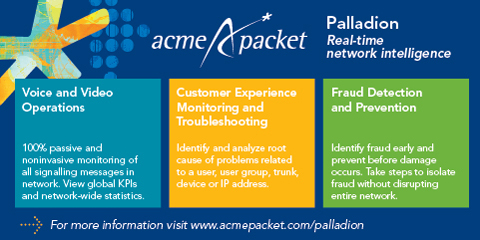Is VoLTE Ready for Prime-time?
By: Becky Bracken

Listen, no oneâs trying to talk mobile operators out of their enthusiasm for voice over LTE. There are incredible benefits to the technology, and itâs going to be hugeâlike, Seinfeld huge.
Someday.
Voice over LTE, or VoLTE, enables rich communication services (RCS), which allow operators to compete head-to-head with over-the-top (OTT) players and for voice to be billed as part of the larger data bundle. Itâs also handy for international roaming, and from a communications service providerâs (CSP) perspective, VoLTE will make it possible for voice services to be run on a network much like any other applicationâsomeday.
âThough widespread commercial deployments are still some way off, operators will need to make some tough decisions about the future of their voice services,â Analysys Mason said in its list of telecom predictions for 2013. âPotential cost savings are currently driving the [VoLTE] investment case, but revenue implications are uncertain, and a clear vision for how voice services should evolve in an LTE world has yet to be articulated. HTML5/WebRTC will further stimulate the debate about whether âvoice is just an application.ââ
Thatâs not to say there havenât been early-adopter operators such as MetroPCS aggressively pursuing VoLTE services; in fact, most major CSPs are proposing pretty ambitious-sounding timelines to make such services available to their customers. But the industry is in the midst of a ânew networkâ overhaul taking place at wildly variable rates across the globe, with some real-world issues surrounding consumer-facing hardware, including short battery life on VoLTE-enabled devices, to name just one. Fortunately, solutions are on the horizon.
âVoLTE offers operators the chance to revolutionize services and respond to OTT offerings,â says Ian Maclean, vice president of strategy and marketing for Mavenir Systems. âOperators are competing for their customersâ attention and loyalty, and VoLTE opens the door, alongside other rich communication services, to enable operators to build bundled groups of value-added applications that meet customersâ needs and create sticky new services.â
However, before that door can swing wide, there are a few kinks that still need to be worked out.
VoLTE device quality
Device testing specialist Spirent found that VoLTE-enabled devices deplete power twice as fast as those making a traditional 2G call. But a recent test of the newer LG Spirit 4G on the MetroPCS LTE network showed a sizable 35 percent improvement in power consumption when making a VoLTE call. In addition, the report found that the combination of improved current drain and increased battery capacity translates to an overall battery life improvement of 122 percent for VoLTE calls, making it comparable to CDMA calls on the previous device.
âWe conducted this second round of VoLTE battery-performance tests to gain some understanding of whether recent technology advances have helped decrease battery drain and improve capacity for VoLTE calls,â says Nigel Wright, Spirentâs vice president of wireless. The results would appear to be encouraging: when the company measured and quantified the impact of calls placed on the Dallas metropolitan marketâs CDMA and 4G LTE networks, it discovered that the combination of reduced battery drain and increased capacity translated to an overall battery-life improvement of 122 percent for VoLTE calls, making them comparable to CDMA calls on previous devices.





















